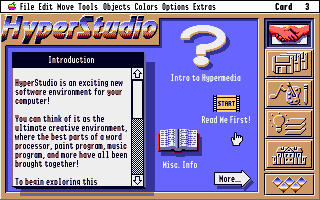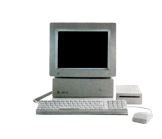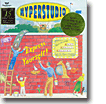Hyperstudio 3.1
Your Rating: Not Yet Rated
Average Rating: 4.7 (6 people have rated this item.)
RAM Requirement: 1.5 meg RAM
Control: Mouse and Keyboard
Release Status: Abandonware
Year: 1989
Publisher: Roger Wagner Publishing
Developers: Michael O'Keefe, Dave Klimas, Jeff Smith, et al
System 6 Compatible: Yes
Hard Drive Installable: Yes
 Download 2image Archive (5094k)
Download 2image Archive (5094k)
 Download the manual in PDF format (38554k)
Download the manual in PDF format (38554k)
All ebay results related to this archive:
No Results for 'Hyperstudio 3.1' for the Apple IIGS available on Ebay
Current Apple IIGS related Auctions Listed By Time Left:
Vintage Software Apple II IIe IIc IIgs RUSSIA The Great War in the East
LEGO TC Logo - Super Rare DACTA - APPLE IIe & IIgs - Interface Card & Cable 9767
Apple ADB Touchpad Mouse Mice Replacement for G5431 m1042 M2706 A9M0331 IIGS IIe
Phonics Prime Time 1.0 by MECC for Apple II+, Apple IIe, Apple IIc, Apple IIGS
Sound Tracks 1.0 by MECC for Apple II+, Apple IIe, Apple IIc, Apple IIGS

Before the Web, there was HyperCard, a creative application package developed and released in the late 80s by Apple for the Macintosh. It gave the user the ability to create 'Hyper Media' - the combination of images, text, sound and interactivity. Which was coined first, hypermedia or multimedia, I don't know, but HyperCard represented one of the first products to make it happen.
A Hyper Media file was called a 'stack', which contained any number of 'cards'. On each card, text, graphics, sound and music can be laid out. But more than that, you could include buttons to control interactivity - click on a button to reveal an animation or play a sound. Move on to the next card in series to reveal more content. In essence, it did then what the web does now, only you don't need to know any code to do it and you're not restricted in any way as to how you can create layouts.
Roger Wagner could see the potential of a HyperCard type product for the IIGS. After all, surely it would have more impact on the IIGS with its colour graphics and brilliant sound over a black and white Mac?
And so HyperStudio was born and with it, came not only software, but a sound digitising card that required no slot and with the first version of HyperStudio, a small external speaker. To use this included hardware and sample from a microphone or other audio input, the included SoundShop program can enable you to record, edit, trim and add effects to sounds, which can then be placed into HyperStudio.
Also included is Sight n Sound, where you can add a startup pic and sound to a GS/OS boot disk.
When you begin using any version of HyperStudio the Home Stack included with the program starts automatically and from this you soon begin to understand how the program works as you read the introductory notes and play with the examples provided.
Version 3.1g was the last version of the program produced by Roger Wagner, and by that time and it had developed into something both programmers and non-programmers alike could get their teeth into. The scripting language provided allowed those with programming skills to really create more powerful stacks while the drag and drop interface allowed anyone, even kids, to quickly and easily make their own hypermedia.
HyperCard for the IIGS first appeared in 1991 and it's difficult to gauge whether this competing product helped push prices down and increased features, or simply split the market unnecessarily. Although similar, it appears that HyperStudio was the easier to use of the two, a fact supported by the release of HyperStudio, oddly enough, for the Mac. It was as successful in schools on the Mac as it was on the IIGS and continues today. In fact Hyperstudio 5 has been announced.




